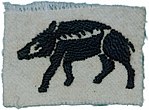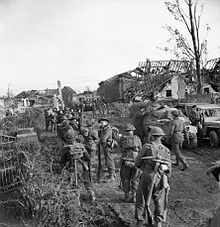
The 43rd (Wessex) Infantry Division was an infantry division of Britain's Territorial Army (TA). The division was first formed in 1908, as the Wessex Division. During the First World War, it was broken-up and never served as a complete formation. It was reformed in the TA in 1920, and then served in the campaign in North West Europe from June 1944 until May 1945, during the Second World War. The division suffered heavy casualties and gained an excellent reputation. After the Second World War, the division formed part of the postwar TA, and became the 43rd (Wessex) Division/District in 1961. It was finally disbanded in 1967.

The 36th Infantry Brigade was an infantry brigade formation of British Army that fought in the First World War, as part of 12th (Eastern) Division, on the Western Front. The brigade also fought in the Second World War, with the 12th (Eastern) Infantry Division, in France, and later with 78th Infantry Division in Tunisia and Italy.
The 130th Brigade, originally the Plymouth Brigade was an infantry formation of Britain's Volunteer Force, Territorial Force, and later Territorial Army (TA). In the First World War the brigade was in British India for most of the war and did not see service as a complete formation, but many of its battalions fought in the Middle East campaigns. The brigade did see action during the campaign in North West Europe of the Second World War, distinguishing itself at actions such as Operation Jupiter, the capture of Mont Pinçon, Operation Market Garden, at 'Dorset Wood' and at Hengelo. As 130 Brigade it continued in the postwar TA until 1961.
The 129th Infantry Brigade was an infantry brigade of the British Army that served during both the First and Second World Wars. In both wars the brigade was part of 43rd (Wessex) Infantry Division.

The 29th Infantry Brigade was an infantry brigade unit of the British Army. It was originally raised in 1914 and saw service during the First and Second World Wars and the Korean War.

The 145th Infantry Brigade was a regional brigade of the British Army that saw active service in both the First and the Second World Wars, disbanding in 1943 and being reformed in the 1990s. The Brigade was renamed Headquarters 11th Infantry Brigade and Headquarters South East in October 2014.

The 210th Independent Infantry Brigade (Home) was an infantry brigade formation of the British Army organised during the Second World War to command a group of newly raised Home Defence battalions. It was later converted to a frontline brigade that served (under a new name) with distinction in the later years of the war, the 38th (Irish) Infantry Brigade.
227th Brigade was an infantry formation of the British Army formed for Home Service under various short-lived titles in the First and the Second World Wars. Later it was upgraded to a field formation composed of Scottish troops, and saw heavy fighting in the Normandy and North West Europe Campaign.
The 158th Infantry Brigade was an infantry brigade of the British Army that served in both the First and Second World Wars, before being disbanded in 1968. Throughout its existence the brigade was assigned to the 53rd (Welsh) Infantry Division and was composed almost entirely of Territorial battalions from the Royal Welch Fusiliers.

The 5th Indian Infantry Brigade was an infantry brigade formation of the Indian Army during World War II. It was converted from the 9th Indian Infantry Brigade in September 1939, and assigned to the 4th Indian Infantry Division. The brigade first moved to Egypt and took part in the early battles in North Africa. Then in 1941, it moved to the Sudan with the 5th Indian Infantry Division. Returning to 4th Indian Division command it took part in the Syria-Lebanon Campaign. The brigade then returned to North Africa coming under command of the 5th and 10th Indian Infantry Divisions, and the 50th (Northumbrian) Infantry Division and the 51st (Highland) Infantry Division in the Campaign in Tunisia. The brigade once more returned to the 4th Division for the Italian Campaign and the Greek Civil War.
The 17th Indian Infantry Brigade was an infantry brigade formation of the Indian Army during World War II.
233rd Brigade was an infantry formation of the British Army in the First and the Second World Wars
The 134th Infantry Brigade was an infantry brigade of the Territorial Force, part of the British Army. It was formed in the First World War as a duplicate of the Hampshire Brigade and was originally formed as the 2nd/1st Hampshire Brigade in 1914–1915 before later being renamed as the 134th Brigade. It was sent overseas to India in December 1914 to relieve Regular Army units for service in France. The brigade remained there for the rest of the war, supplying drafts of replacements to the British units fighting in the Middle East and later complete battalions. By September 1917 the last of its battalions had departed.
203rd Infantry Brigade was a Home Defence formation of the British Army during the Second World War.

206th Independent Infantry Brigade was a Home Defence formation of the British Army during the Second World War.
The 211th Infantry Brigade was a Home Defence formation of the British Army during the Second World War.
The Hampshire Brigade, previously the Portsmouth Brigade and later 128th (Hampshire) Brigade, was an infantry formation of the British Army of the Volunteer Force, Territorial Force (TF) and Territorial Army (TA) in existence from 1889 until after the Second World War. It served in British India during the First World War, but not as a complete formation. During the Second World War, the 128th Infantry Brigade fought in the Tunisia Campaign, in the Italian Campaign, and later in the Greek Civil War. The brigade was composed entirely of battalions from the Hampshire Regiment.

43 (Wessex) Signal Regiment was a Territorial Army (TA) unit of the British Army's Royal Corps of Signals from 1920. It had its origins in a Volunteer unit of the Royal Engineers formed in the West Country in 1860 and provided the communications for the 43rd (Wessex) Infantry Division during World War II. Its successor still serves as a squadron in today's Army Reserve.

The 1st Wiltshire Battery, Royal Field Artillery, and its successors were part-time Territorial Force units of the British Army from 1908 to 1950. It carried out garrison duties in India during World War I and saw active service in the Third Afghan War. It served in various units in the interwar years, finally becoming a full regiment in time for World War II. It saw action with 43rd (Wessex) Infantry Division in the campaign in North West Europe, including Operations Epsom, Jupiter and Bluecoat in Normandy, the crossing of the Seine, the battle for Arnhem in the Low Countries, and then Operations Clipper, Blackcock, Veritable and Plunder across Germany. Its short-lived postwar successor unit had little or no Wiltshire connection.

The 179th Field Regiment was a unit of the Royal Artillery, formed by the British Army during World War II. First raised in 1940 as infantry of the Worcestershire Regiment, after serving in the garrison of Iceland it was converted to the field artillery role in 1942. It fought with 43rd (Wessex) Division in the campaign in North West Europe. It was disbanded after the war.












